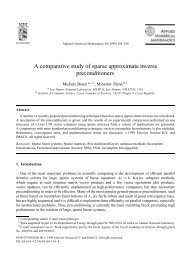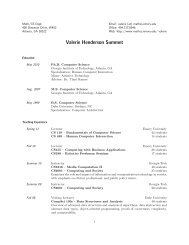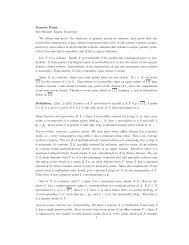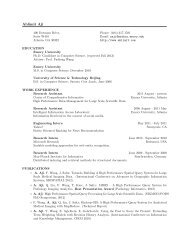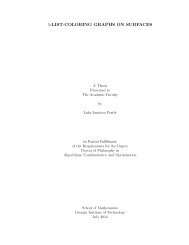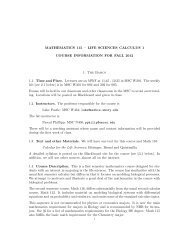Chapter 3 Solution of Linear Systems - Math/CS
Chapter 3 Solution of Linear Systems - Math/CS
Chapter 3 Solution of Linear Systems - Math/CS
You also want an ePaper? Increase the reach of your titles
YUMPU automatically turns print PDFs into web optimized ePapers that Google loves.
54 CHAPTER 3. SOLUTION OF LINEAR SYSTEMS<br />
Applying either type <strong>of</strong> elementary operations to a linear system does not change its solution set.<br />
So, we may apply as many <strong>of</strong> these operations as we need in any order we choose and the resulting<br />
system <strong>of</strong> linear equations has the same solution set as the original system. Of course, in floating–<br />
point arithmetic each operation <strong>of</strong> type (b) introduces error due to round<strong>of</strong>f so we do need to pay<br />
some attention to the effects <strong>of</strong> these operations.<br />
For a linear system <strong>of</strong> order n, GE uses n stages to transform the linear system into upper<br />
triangular form. The goal <strong>of</strong> stage k is to eliminate variable xk from all but the first k equations. To<br />
achieve this goal, each stage uses the same 3 steps. We illustrate these steps on the linear systems<br />
<strong>of</strong> order 3 presented in Examples A and B in Figs. 3.7 and 3.8, respectively.<br />
Stage 1<br />
The goal <strong>of</strong> stage 1 is to eliminate x1 from all but the first equation.<br />
The first step, called the exchange step, exchanges equations so that among the coefficients<br />
multiplying x1 in all <strong>of</strong> the equations, the coefficient in the first equation has largest magnitude. If<br />
there is more than one such coefficient with largest magnitude, choose the first. If this coefficient<br />
with largest magnitude is nonzero, then it is underlined and called the pivot for stage 1, otherwise<br />
stage 1 has no pivot and we terminate. In Example A, the pivot is already in the first equation so<br />
no exchange is necessary. In Example B, the pivot occurs in the third equation so equations 1 and<br />
3 are exchanged.<br />
The second step, called the elimination step, eliminates variable x1 from all but the first equation.<br />
For Example A, this involves subtracting m2,1 = 2/4, times equation 1 from equation 2, and<br />
subtracting m3,1 = 1/4 times equation 1 from equation 3. For Example B, this involves subtracting<br />
m2,1 = −1/2 times equation 1 from equation 2. Each <strong>of</strong> the numbers mi,1 is a multiplier; the first<br />
subscript on mi,1 tells you from which equation the multiple <strong>of</strong> the first equation is subtracted. The<br />
multiplier mi,1 is computed as the coefficient <strong>of</strong> x1 in equation i divided by the coefficient <strong>of</strong> x1 in<br />
equation 1 (that is, the pivot).<br />
The third step, the removal step, removes the first equation and makes it the 1 st equation <strong>of</strong><br />
the final upper triangular linear system.<br />
Stage 2<br />
Stage 2 continues with the smaller linear system produced at the end <strong>of</strong> stage 1. Note that this<br />
smaller linear system involves one fewer unknown (the elimination step in the first stage eliminated<br />
variable x1) and one fewer equation (the removal step in the first stage removed the first equation)<br />
than does the original linear system. The goal <strong>of</strong> stage 2 is to eliminate the variable x2 from all but<br />
the first equation <strong>of</strong> this smaller linear system.<br />
As stated before, each stage uses the same 3 steps. For stage 2, the exchange step exchanges<br />
equations so that among the coefficients multiplying x2 in all <strong>of</strong> the remaining equations, the coefficient<br />
in the first equation has largest magnitude. If this coefficient with largest magnitude is<br />
nonzero, then it is called the pivot for stage 2, otherwise stage 2 has no pivot and we terminate. The<br />
elimination step eliminates the variable x2 from all but the first equation. For each <strong>of</strong> Example A<br />
and B, we compute a single multiplier m3,2 which is the coefficient <strong>of</strong> x2 in equation 2 divided by the<br />
coefficient <strong>of</strong> x2 in equation 1 (that is, the pivot). (Note that the numbering <strong>of</strong> the multiplier m3,2<br />
corresponds to the equation and variable numbering in the original linear system.) Then we subtract<br />
m3,2 times the first equation <strong>of</strong>f the second equation to eliminate x2 from the second equation. The<br />
removal step then removes the first equation and uses it to form the 2 nd equation <strong>of</strong> the final upper<br />
triangular linear system.<br />
Stage 3<br />
Stage 3 continues with the smaller linear system produced by the last step <strong>of</strong> stage 2. Its goal is to<br />
eliminate the variable x3 from all but the first equation. However, in this, the last stage <strong>of</strong> GE, the<br />
linear system consists <strong>of</strong> just one equation in one unknown, so the exchange and elimination steps<br />
do not change anything. The only useful work performed by this stage consists <strong>of</strong> (1) identifying



